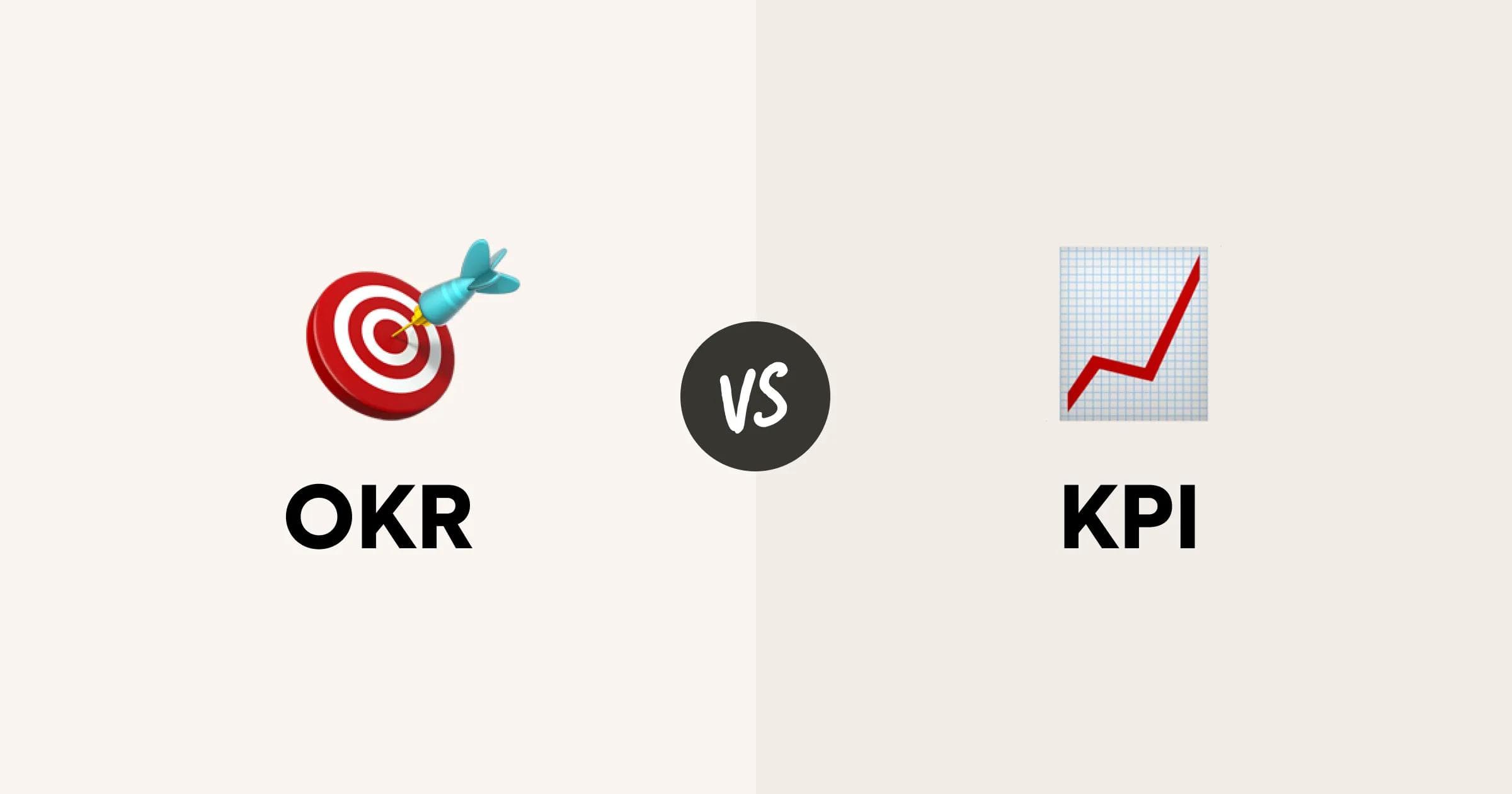The 11 best OKR Books of 2025
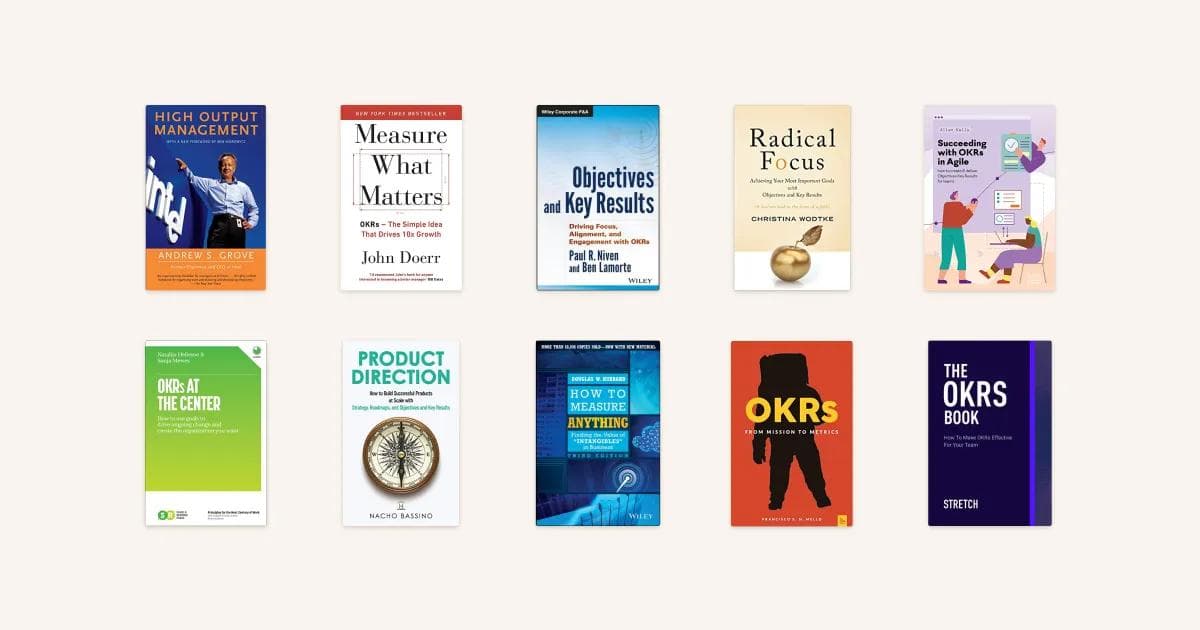
OKR books are the perfect start for beginners to familiarize themselves with the subject, the history of its development and its terminology. But even for experienced OKR practitioners who want to acquire expert knowledge, there are a number of OKR books that delve deeper into the subject matter. Below you will find a selection of the currently best OKR books for different use cases.
1. „Measure What Matters“ by John Doerr
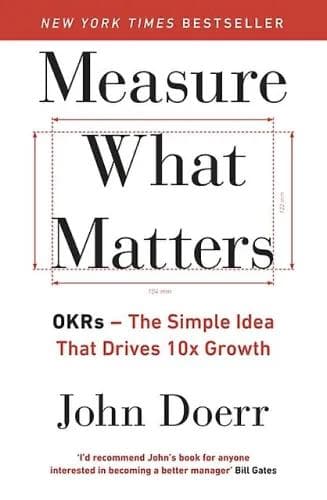
John Doerr is also referred to as the "foster father of OKRs", as he introduced the method at the time as an advisor and investor at Google and thus contributed significantly to the popularity of OKRs. Doerr himself learned the OKR method from the founder of OKRs and former Intel CEO, Andy Grove.
For this reason, Measure What Matters is often recommended as an introductory OKR book when first learning about OKRs.
In the first part of the book, Doerr provides an overview of the origin story and key benefits of the OKR method, which he illustrates with real case studies (such as Intel, Google, the Bill Gates Foundation, and singer Bono).
In the second half of the book, Doerr gives an outlook on where the world of work will go in the future. Here he introduces the instrument CFRs (Conversations, Feedback, Recognition), which in combination with the OKR method forms the foundation of continuous performance management. He also explains how continuous performance management replaces outdated methods such as annual target agreements and performance reviews and illustrates this using the example of the software company Adobe.
💡 Who should read this book?
The book is unreservedly recommended as a way of getting to grips with the subject and learning from the "foster father of the OKRs" himself. In particular, Doerr's proximity to Intel and Google creates an atmospheric density that only a "first-hand witness" can convey. However, anyone expecting practical tips that can be implemented directly, such as the correct formulation of OKRs, will be disappointed. In addition, some of the OKR examples from the book also do not correspond to "good practice," so one should not blindly follow them. Other books and resources are more appropriate here.
2. „You Are A Strategist“ by Sara Lobkovich
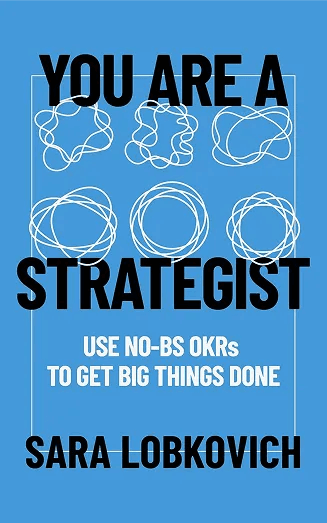
"You Are a Strategist: Use No-BS OKRs to Get Big Things Done" by Sara Lobkovich is a practical guide that bridges the common gap that befuddles leaders and staffers alike: between high-level strategy and day-to-day execution. Lobkovich, a business strategy coach with extensive experience implementing OKRs at organizations focused on improving human metrics (such as graduation rates, healthcare outcomes, and customer and product experiences) addresses a problem many companies face: having ambitious mission statements and sometimes even well-crafted strategies, but lacking the "connective tissue" for the organization at large to turn them into results.
The book introduces two frameworks: the Connected Strategic One-Sheet, which distills organizational strategy onto a single actually-useful page, and No-BS Objectives and Key Results (OKRs)—a straightforward approach to OKRs that combines clear, directional objectives with empirically measurable key results. Unlike traditional OKR books that focus heavily on theory, that over-focus on creating OKRs, or that revolve around tech giant case studies, Lobkovich emphasizes practical implementation for innovation-driven environments where performance depends on improving human experiences, not just making numbers on dashboards “look good.”
What sets this book apart is how well-scaffolded its focus is on creating an "alignment layer" between strategy and delivery, and, on the focus on changing behavior, not just writing OKRs. Lobkovich’s practices foster a culture where teams can experiment, take calculated risks, and learn from setbacks. With step-by-step guidance, charts, and real-world examples, it demystifies the OKR process and provides actionable frameworks that transform abstract strategy into concrete results.
💡 Who should read this book?
This book is ideal for leaders and teams struggling to connect strategic vision with execution, change makers seeking to implement OKRs simply and efficiently without getting lost in theory, and organizations wanting to foster innovation and accountability through a practical, no-nonsense approach to strategic decision-making and behavior.
3. „High Output Management“ by Adam Grove
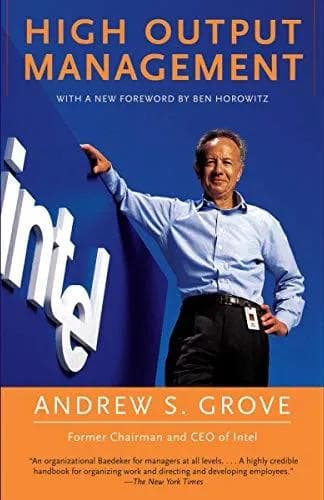
"High Output Management" by Andrew Grove, former CEO and board member of Intel, is a standard work of management reading and with its chapter on Objectives and Key Results also one of our top 10 OKR books. The book was published in 1983 and has been recognized as the "bible of management" by various management experts from both business and research. Even 40 years after its first publication, this bible provides relevant knowledge.
This is primarily due to its content, which focuses more on classic "management" than on the new model of "leadership." In the first part, Grove discusses an output-oriented management approach, according to which leadership principles of companies that are primarily engaged in manufacturing products are transferred to other forms of entrepreneurship. Following this, it is emphasized that "the output of a manager is the output of an organized unit that is under his or her influence." In other words, anyone who wants to manage a company or a team manages a multitude of individuals who, when perceived as such, keep a business running. Individuals rarely do. The subchapter "Introduction to OKRs" is also found in this context.
💡 Who should read this book?
This classic is likely to be of particular interest to readers who prefer to read pragmatic manuals rather than pompous guidebooks and who want to improve their management skill set quickly and effectively.
4. „Objectives and Key Results - Driving Focus, Alignment, and Engagement with OKRs“ by Paul Niven and Ben Lamorte
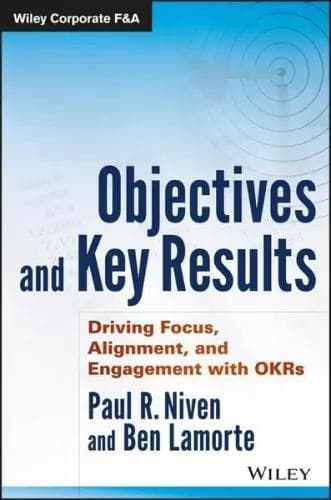
With "Objectives and Key Results - Driving Focus, Alignment, and Engagement with OKRs”, Paul Niven and Ben Lamorte have written, arguably the first, truly full-blown OKR handbook. Published in 2016, it shows business and organizational leaders how to create more effective focus in their team, align more precisely, and build an effective culture of communication. Niven and Lamorte are both leaders in the field of OKR research and, through their consulting positions, are able to provide a practical and business-oriented perspective. All of this makes "Objectives and Key Results - Driving Focus, Alignment, and Engagement with OKRs" one of the essential OKR books.
Those who choose to read Niven and Lamorte’s book will enjoy clearly structured content that guides interested readers through the process of launching their own OKR program from A to Z, so to speak. They begin the journey with a brief overview of OKRs in general and why modern organizations benefit from structuring themselves around Objectives and Key Results. The chapter "Preparing for Your OKRs Journey" discusses what differentiates effective OKRs from less effective ones and provides instructions on how to successfully implement them in your own team or company. More takeaways: practical, easy-to-use tips for day-to-day team management and suggestions regarding how to make OKRs sustainable. In the last chapters, Niven and Lamorte analyze various OKR examples in the form of several case studies.
💡 Who should read this book?
"Objectives and Key Results - Driving Focus, Alignment, and Engagement with OKRs" is recommended to all readers who want to deepen their own understanding of OKRs, but do not want to get bogged down in hardly applicable theory.
5. „Radical Focus – Achieving Your Most Important Goals with Objectives and Key Results“ by Christina Wodtke
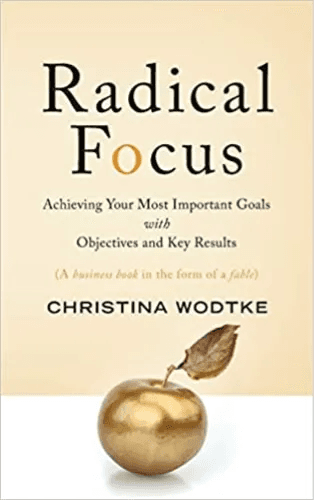
"Radical Focus" by Christina Wodtke is the OKR book for anyone who wants to know why their OKRs may not be working as well as planned after all. Wodtke is a professor at Stanford University who focuses on high-performing teams, and she begins her book with the fictional story of Hanna and Jack's Silicon Valley startup, which fails to achieve the goals they set for themselves despite their high expectations. It is the highlighting of potential OKR pitfalls through a pictorial anecdote that makes "Radical Focus" one of our top 10 OKR books.
Hanna and Jack have started a tea startup that is struggling to get off the ground. The story begins with an ultimatum from their only investor, who demands that they implement a working OKR program. If they fail to do so, he will withdraw his investment. Based on this premise, it teaches how to motivate a diverse team to pursue a single, challenging goal. In a world where single-minded focus on a single endeavor – whether as a team or as an individual – seems to be an increasingly rare skill, Wodtke provides a guide on how to achieve just that. For the author, it doesn't matter whether you work at a small startup or a tech giant – because you should sharpen your focus anywhere.
Wodtke starts with an overview of why some Key Resultats simply don't find fulfillment - and is thus perhaps more in touch with the reality of life for many founders or people interested in OKRs than the many best practice examples from the other OKR books in this list. Reasons for "failure" – if you want to put it that way – are, according to Wodtke: the lack of prioritization of goals, including poor communication around them; no precise plan on how to achieve these very goals; too little time allocated to the activities that would really help in achieving them; and the tendency to give up instead of getting up to try again. The basic idea that OKRs should be used primarily to define a clear focus from which to never deviate, if possible, is clearly the core message of the book.
💡 Who should read this book?
As mentioned at the outset, "Radical Focus" is of interest primarily to those who may already have had unsatisfactory experience in OKR implementation and want to know what exactly could be done differently, and those who want to avoid the pitfalls in the first place. Finding those can be hard enough. It's fortunate that Hanna and Jack have already stumbled across all the problems, so you don't have to do that repeatedly yourself. Yay!
6. „Succeeding with OKRs in Agile: How to create & deliver objectives & key results for teams“ by Allan Kelly
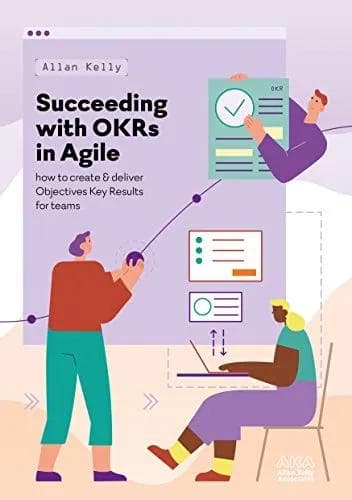
Do you struggle to keep your agile team focused? Do you feel like you need to do more than check every few weeks that nothing has fallen behind? Do you want to implement OKRs on your team? These are the questions Allan Kelly asks at the beginning of the book "Succeeding with OKRs in Agile: How to create & deliver objectives & key results for teams" to his readers. Kelly has written several books on agile teams and has been a respected coach in the field for years. "Succeeding with OKRs in Agile", published in paperback in 2021, made it onto our list of the best OKR books.
As the title suggests, this is an introduction to OKRs for professionals who have had experience working in or leading agile teams in their careers. Kelly takes the reader on an - admittedly very IT-heavy - journey through the various advantages of OKR structures in agile teams and does his best not just to dryly rattle off his views, but also to include a little humor. For a change, this actually reads quite well and is a nice way to lighten things up. "Succeeding with OKRs" is divided into two sections, "Why OKRs" and "Writing OKRs." Within these sections, Kelly provides detailed insights into the underlying concepts of the goal-setting method and delights with tailored tips and tricks regarding the accurate formulation of both Objectives and Key Results. At the end of each chapter is a compact summary that is especially useful for quick reference.
Kelly does not focus on the goal of company-wide alignment, as is often found in the OKR literature, but rather on the recurring interplay of openness and focus. Where openness is important in finding, categorizing, and discussing the objectives, for example, more focus and rigor are needed in the implementation phase. He himself feels he has written exactly the book he would have wanted to read when he first started looking at OKRs. And we thank him for it!
💡 Who should read this book?
Leaders and members of agile teams as well as OKR consultants and agile coaches.
7. "OKRs At The Center: How to use goals to drive ongoing change and create the organization you want" by Natalija Hellesoe and Sonja Mewes
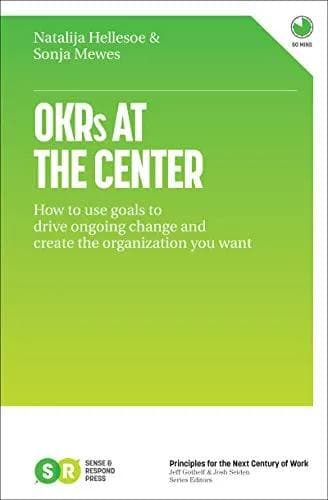
While Christina Wodtke's "Radical Focus" uses the OKR journey of a fictitious startup from Silicon Valley as a means of illustration, Natalija Hellesoe and Sonja Mewes use real-life examples. "OKRs At The Center" analyzes OKR strategies of three real companies for the reader, examining from different points of view why they succeeded or failed or something in between (of course, there is almost always something in between with OKRs). The key message emerged clearly after reading the book: Changing the way a company formulates its goals can quickly lead to unforeseen changes in the company's culture that can positively impact it in the long run.
Due to its compactness and the authors' decision to clearly underpin any theory with real-life examples without any detours, the 98 pages are pleasant to read while still giving you the feeling that you have made a significant leap in your understanding of successful OKR implementation. Natalija Hellesoe and Sonja Mewes both work as change agents, advising companies of all sizes through the various stages of their OKR journey. This market-facing background has obviously provided an extensive understanding of the diverse issues that can arise around OKR implementation, and manifests itself in a pleasing balance of theoretical depth and practicality. A good example that even scientific literature deserves good storytelling!
💡 Who should read this book?
Due to its brevity, "OKRs At The Center" can be recommended to anyone who is interested in OKRs, as it does not take that long to read through. Readers who have already gained experience with the pitfalls of a successful OKR strategy - or who may even be in the process of implementing one - will benefit most.
8. „Product Direction: How to build successful products at scale with Strategy, Roadmaps, and Objectives and Key Results“ by Nacho Bassino
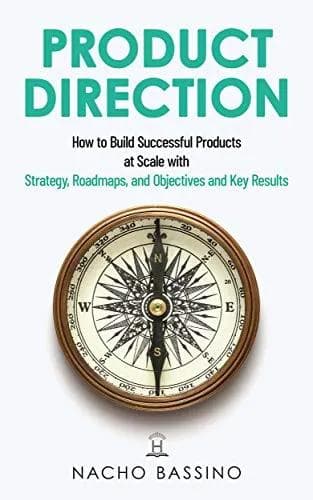
The next book in our OKR book list is also characterized by its practical relevance: "Product Direction: How to build successful products at scale with Strategy, Roadmaps, and Objectives and Key Results" by Nacho Bassino is a hands-on guide for all product leaders. Bassino provides readers with a 250-page toolbox in which observant readers will find everything they need from meticulously planning a product to successfully implementing and establishing it in the marketplace. The beauty of it is that it doesn't matter what kind of product it is, the framework remains the same. At least that's what Bassino says.
He starts his execution with a basic introduction to the craft of successful strategy formulation. In Chapter 2, readers get a detailed look at the art of constructing a reasonable "roadmap" for the pre-defined strategy in the product implementation. Here we move close to the topic of "OKRs", which will be discussed in the third and last chapter: The field of product direction is a subcategory of product management and has the primary purpose of clearly defining problems and goals that are then to be solved or achieved by the respective product in a particularly tailored and user-friendly manner. Strategy and roadmap help with this. And because OKRs are a kind of elaborate roadmap for the general direction of travel of a company, intensive study of the problems that a product is supposed to solve can naturally also be very helpful in OKR formulation.
💡 Who should read this book?
In general, "Product Direction" is recommended to all readers who are even remotely involved in product management. And all others interested in OKR are also recommended to take a look at the book. It never hurts to look from the smaller to the bigger picture and to understand how the other craft works.
9. „How To Measure Anything“ by Douglas Hubbard
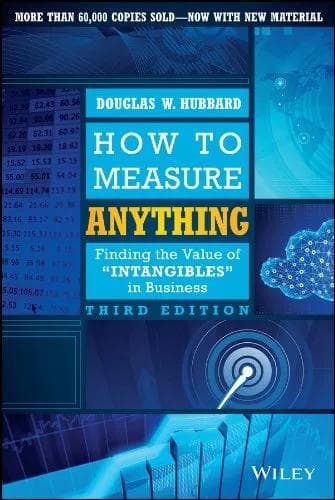
Away from the hands-on toolboxes and towards the big picture: "How To Measure Anything" by Douglas Hubbard is the next on the OKR book list and has no less a claim than to explain to readers how non-measurable information can become measurable variables. Those who think that soft facts are all about feeling may be proven wrong by "How To Measure Anything". Douglas Hubbard is the founder of "Applied Information Economics" and was formerly a business analyst at an auditing firm. AIE is a method for measuring information values in cases where the information cannot be broken down to zeros and ones. It is based on various practices from the fields of decision theory and risk analysis, and can help managers, for example, better calculate the consequences of potentially costly decisions - and make them differently if necessary. But really, it can help pretty much anyone make critical decisions a little more carefully in the less predictable areas of their own lives. When formulating Key Results, it is often difficult to find measurable metrics. The book could remedy this problem by providing methods to measure the right things.
The thesis of the book is relatively simple: In an unclear situation, relevant information is able to reduce this ambiguity. The value of the information is calculated from its potential to avert a wrong decision and the potential cost of that wrong decision if it is made. He argues that the techniques bookmakers use to determine the monetary value of a life, a bond fund, or the correct tip in a horse race are applicable to quite a few other areas of life. The important thing to understand here is: We don't need to have the exact value of a piece of information to make a decision, but to be able to estimate it well enough to make an informed decision.
💡 Who should read this book?
The ability to make things measurable and make good decisions is, of course, not only of great benefit to executives, but actually to every person who may have ever misjudged something, in whatever situation. Let him who is without sin here cast the first stone, this reading recommendation probably applies to everyone!
10. “OKRs, From Mission to Metrics: How Objectives and Key Results Can Help Your Company Achieve Great Things“ von Francisco S. Homem de Mello
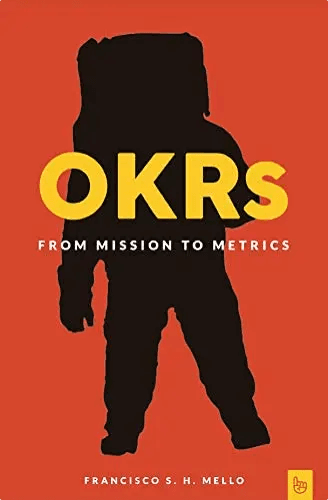
The author of this book has already published various other books on performance management and leadership. This OKR book benefited a lot from the author's expertise in related fields.
Especially the decision of De Mello to dedicate two chapters to the insightful overview of the history of goal management in general and OKRs in particular is very pleasing. Here it becomes very clear what distinguishes OKRs from "classical" models of goal setting in companies and makes evident, especially for beginners, why they are so powerful. This bridge from the "old" to the "new" world should also appeal to readers who find themselves in the position of establishing an agile framework in a traditional company.
De Mello continues to do a great job of putting the complex content across in catchy phrases in a casual way that makes you feel like you can get started right away. Another nice aspect is that, despite his obvious affinity for OKR (why else would he write this book), De Mello's explanations are always accompanied by a slightly critical distance. And this can help especially beginners to keep a realistic view on OKRs and to appreciate the real advantages of the most important management system of the future. Enjoy!
11. „How To Make OKRs Effective For Your Team“ by Stretch HQ
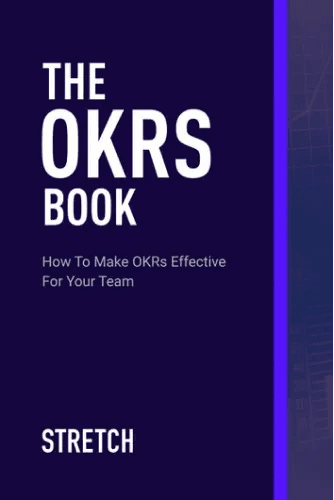
The final book in our top 10 OKR books is "How To Make OKRs Effective For Your Team" by Stretch HQ. Just 27 pages long, it is the shortest book on the list and doesn't claim to teach any in-depth or novel theory, nor does it provide any detailed examples. And that's its strength, because not everyone who starts out interested in OKRs can dive right into big theoretical bulwarks. "How To Make OKRs Effective For Your Team" takes readers by the hand and explains straightforwardly how to properly set OKRs in a team, how to integrate their achievement into the daily work process, how to build a sense of community around these goals, and finally how to measure them.
💡 Who should read this book?
Of course, 27 pages cannot convey everything that is needed to actually drive a successful OKR strategy, but for all those interested in getting a first feel, Stretch HQ's handbook can definitely be recommended without reservation. And after that, there is of course this Top 10 list, with which everyone can put together his or her own individual OKR book journey - happy reading!



